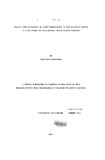| dc.description.abstract | The significance of land is that it constitutes the most important economic, cultural and
political issues in Kenya today. It was true when Kenya became a colony dominated by
European settlers. It remained true through the Mau Mau war and the transition to
independence, both of which revolved around competing demands for land. And it has
remained true since the 1980's to-date, in a country where the educated, the rich and poor
alike consider land as the single most important form of personal wealth and is deeply
entrenched with its distribution and use.
Subdivision of land into small unviable holdings is a serous problem limiting the
agricultural productivity of land in the Settlement Schemes (formerly called the white
highlands). This study considers the problem of land subdivision in. Lumakanda
settlement 'scheme in Lugari District. Lumakanda Settlement Scheme was part of the
former white highlands that is now experiencing rapid population growth currently
standing at 4.1% p.a. With good rainfall that is abundant and generally reliable, coupled
with agro-ecological conditions, the area is considered a zone of high agricultural
potential. The predominant crop is the subsistence staple, maize, which is planted once a
year.
Access to factors of production and technological constraints were mentioned as
important factors affecting farmers in Lumakanda Settlement scheme. The declining land
t sizes, lack of capital and access to credit, and lack of appropriate farming technology has
substantially limited production on sub-divided former European farms. The study
revealed that the household structure and the need for alternative sources of income were
the main factors influencing more subdivisions of land. The rapid population growth has
had tremendous impact on the settlements economy and ecology. The high immigration
has not only changed land ownership pattern, but also the mode of production. Hunger
for land has led to both legal and illegal subdivision of land regardless of its productive
capacity. This change in land-use signifies a tremendous intensification of land in the
study area. This calls for better land tenure and farming techniques, research and
technological innovation in Lumakanda Settlement Scheme.
Land subdivisions have led to unviable land units and over-intensification of production
leading to environmental degradation. Subdivision of land was found to be an evolution
of the individual tenure. It emanates out of natural evolution of land. It is spontaneous out
of family subdivisions of land through successive generations and in-migration.
Agriculture is dependent on land, which is the critical primary input. Production has been
affected by three main factors namely:
• Equity in land distribution which IS mainly political and has encouraged land
subdivision
• There is the issue of efficiency in production, and
,
• Changed structures of production arising from the declining land holdings.
Acquisition of factors of production to enhance production leaves most farmers
vulnerable to manipulation leading to sale of land. Also most farms were found to be
unable to expand scale operations and therefore handicapped, thereby increasing
problems of viability particularly in terms of absorbing risks
All these problems call for an out side intervention in the form of land reform. Land
reform will lead to equity and efficiency in management and production. This can be in
the form of land consolidation through formation of either common family homesteads or
having shares and non-erection of physical boundaries, thus freeing more land for
agriculture. This will promote use of mechanization and enhance the economies of scale
thus increased production. | en |

